Yugoslav Monuments – An Essay on Art and the Rhetoric of Power
by David Fox
A monument is namely a public phenomenon; the public is the commission which reasoned it and which it is dedicated. The physical open space in which a monument exists is technically the only possible medium of the socio-psychological sphere which the monument is intended for: the spiritual reality of its milieu.
Publicness is the monument’s true nature; this is where the monument grows, stands or fails: in publicness lies all the magnificence or nothingness of the monument. If it lacks this public dimension, the monument is just a mass, sometimes a good sculpture or something else but always a misunderstanding that disappears with the monument’s removal.
Eugen Frankovic, The Publicness of Monuments
A French historian Pierre Nora writes that memory attaches itself to sites. Monuments and memorials are indeed such sites. When we try to rewrite today the art history of Yugoslav sites of remembrance, we are facing a depressing fact: such a history has actually never been written.
The absence of valuable art historical and theoretical texts about political and cultural monuments erected on former Yugoslav territories does not mirror the absence of monuments.
Both the first (1918-1941) and the second Yugoslav state (1945-1991/1992) manifested a real greed for commemorations and genuine passion for spatialization of collective memories. Any such project, however, necessitated the implementation of a particular politics of remembrance and these politics are depended on what is imagined as ‘collective identity’ of a community, a nation, or a state.
American historian John R.Gillis stresses that both memories and identities are often attributed the status of unchangeable ‘material objects’.
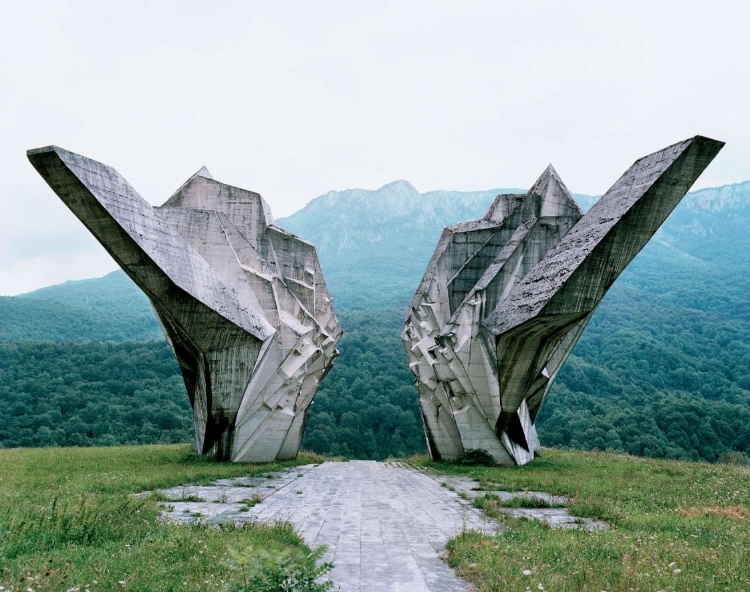
He dismantles this conception, states that we need to be reminded that memories and identities are not fixed things, but representations or constructions of reality, subjective rather than objective phenomena. Therefore, we are constantly revising our memories to suit our current identities.
Public monuments, both those dedicated to political figures and men of culture, are instrumental in these revisions: those which do not suit to ‘’new identities’’ must be removed in order to make place for new monuments which now spatialize newly constructed identities.
A discourse about political memorials, or any other public monument, we can establish today, radically differs from the usual comprehension of monuments traditionally discredited as “art on command” or “art on commission’”. As artworks commissioned by public agency – a national community, a veteran organization or even a state, monuments are believed to be in ‘service of’ a given power, which they should ‘illustrate’.
However, when examining monuments as visual representations, we (should) understand the monument as the site in which power becomes constituted. American art historian David Summers argued that ‘’substitutive images’’ (the representation of rulers) and the space in which they are used, are ipso facto realization of power, not expression of power, but actual form taken by power in one or another place and time.
Monuments, like other types of visual representations we encounter in the public sphere, such as posters, documentary and feature films, postage stamps and press photographs, play, thus, a constitutive and nor merely a reflexive, after-the-fact-role.

A discourse on memorial sites in two Yugoslav states is not unique. It does not differ much from other countries: since the least the French Revolution, the treatment of public monuments point to the fact that image-making is as old as image-breaking.
Making and breaking are also characteristic of the Yugoslav memorial productions, whereby it should not be forgotten that both Yugoslav states and many of the post-Yugoslav ones were founded after wars.
The Kingdom of Serbs, Croats and Slovenians known as the ‘’ three-name nation’’ (troimeni narod) was founded in 1918 after the First World War. Newly built monuments were meant to establish public memory of war heroism and suffering, but this memory, alas, could be instituted only in some parts of the freshly reunited state, actually composed of war winners and war losers.
When this state became a ‘one-name nation’ (jednoimeni narod) and was accordingly renamed the Kingdom of Yugoslavia (1924-41), it started to promote the ideology of unitary Yugoslavism, which was constituted not only by dictatorship but also via monuments to Yugoslav kings of Sebian Karadjordjevic dynasty: Peter I ‘’the Liberator’’ (died at 1921) and Aleksandar ‘’the Great Unifier’’( assassinated in 1934).
Between 1923 and 1940, some 215 monuments or memorial marks dedicated to the deceased rulers had been erected all over the Yugoslav kingdom. None of these monuments survived, but the sculptors who designed them ( Ivan Mestrovic, Lojze Dolinar, Frano Krsinic, Antun Augustincic and Sreten Stojanovic) did.
All of them would again become engaged in the production of memorials in ‘new’ Yugoslavia.
The Second Yuguslav State
The second Yugoslav state, proclaimed on 29, November 1943, was also a state born of war. After 1945, the Socialist Federal Republic of Yugoslavia indulged yet again in a statue-mania, which now spatialized the memory of a just war and victory over fascism.
Gained by transnational and multi-ethnic partisans’ forces, it fostered ‘’brotherhood and unity’’ of all Yugoslav people/nations. Thus emerged new memorial sites populated with numberless monuments which, as any such public objects in the world, replayed a collective memory that, since 1945, became institutionalized as ‘their’ history: this was the history of the winners, and winners are keen on selective memories.
In spatializing this memory-as-history, Yugoslav monuments exploited various regimes of representation.
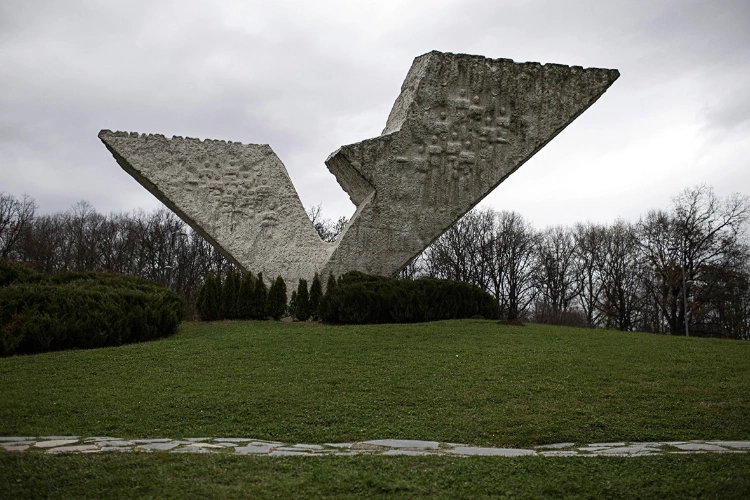
Around 1952-55, the battle between Socialist (mainly academic) Realism and modernism in Socialist Yugoslavia ended with the victory of modernism. Hence, as of the 1960s, the major Yugoslav memorials commemorating ‘’fallen soldiers’’ and ‘’victims of fascism’’ obtained abstract, i.e, modernist shapes; however, parallel to these productions initiated and founded by the Association of Veterans of the People’s Liberation War (Savez Boraca Narodnooslobodilackog rata), monuments based on figurative representation continued to be built all over Yugoslavia till the late 1980s, and often supported by local veterans organizations.
Even if those monuments based on iconic or realistic representations of human bodies (as a rule male bodies) may appear to offer an easier identification and reception by ‘’people’’ , abstractly shaped memorials continue to connote the same ideology: a lack of humanism (understood as the absence of bodily representations) brought about the presence of huge abstract sculptures called organic bodies ( as a rule based on phallic shapes such as obelisks, cylinders, erected forms) which connoted again a rhetoric of power, and last but not least –militarism.
A thematic shift occurred in the late 1960s and early 1970s. Whereas ‘’revolutionary sculptures’’ produced till then restaged the war victory and defeat of fascism, later modernist memorial productions, built on the ‘’sites of the Revolution’’ tended to incept the memory of war as socialist revolution: this happened some thirty years after the war, when memories of it started to fade and meant little to younger generations.
In additions, memorial complexes, designed by artists and/or architects such as Bogdan Bogdanovic, Dusan Dzamonja, Miodrag Zivkovic, and erected on the natural sites where partisan’s victories took place, imply yet another aspect: they suggest revolution to be a natural process.
Therefore, one should abandon a traditional dualism between representational/ figurative and non-representational/abstract procedures. Instead, one should ask in which ways monuments actively performed a spatialization of Communist ideology, whereby the division between iconic and non-iconic representation hardly plays a role.
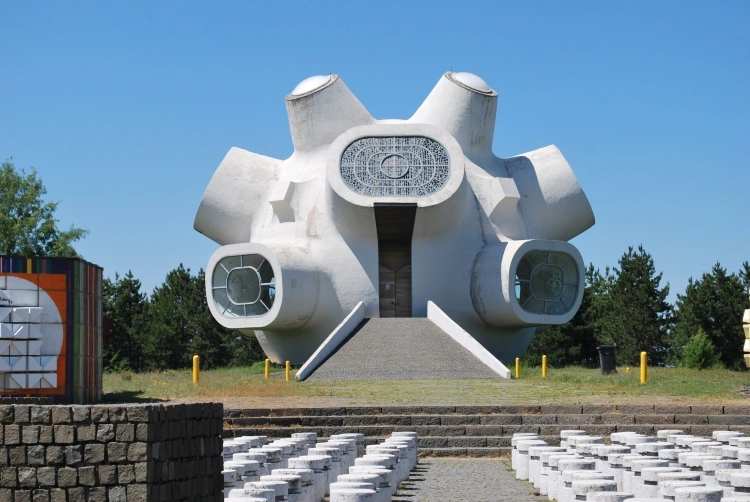
Since the rise of nationalist ideologies in Yugoslavia of the late 1980s, the antifascist tradition became exposed to collective amnesia, and in most, if not all, post-Yugoslav states it is almost completely negated, if not totally erased.
The devastation and destruction of Yugoslav ‘communist’ monuments occurred not only during the Yugoslav wars of the 1990s, but also later. New monuments erected, or re-erected, in post-Yugoslav sovereign states commemorate heroes and victims of war (1991-1999), but not only them.
Each nation-state built its own monuments which now constitute nationalist ideology viewed through the eyes of victimization and national suffering under ‘’foreign power’’ (as a rule neighboring nation/state), under ‘’communists’’ and even under the international community.
Memories re-enacted in political monuments and memorials put up on Yugoslav territories in the twentieth century are generally memories of violence and, linked to it, militarism. However, it would be historically wrong to assume that representation of and reference to violence is specific for monuments erected in bellicose and brutal Balkan region.
In addition, as in other parts of the world, monuments themselves are as often as not exposed to violence.
American art historian W.J.T. Mitchell, in his article The Violence of Public Art, differentiates two types of violence directed against monuments and other public works of art. One is ‘’the official’’ violence of police, juridical or legislative power, as was the case of the post-1989 removal of the ‘’Communist Pantheon’’, which was in the main based on parliamentary decisions.
The other is ‘’unofficial’’ violence performed by angry masses. He asked several questions: Is public art inherently violent, or is it a provocation to violence? Is violence built into the monument in its own very conception?
Is violence simply an accident that befalls some monuments, a matter of the fortunes of history? In this context, he reminds us that monumental productions are generally dedicated to one theme: Much of the world’s public art-memorials, monuments, triumphal arches, obelisks, columns, and statues-has a rather direct reference to violence in the form of war or conquest.
From Ozymandias to Caesar to Napoleon and Hitler, public art served as a kind of monumentalizing of violence, and never more powerfully than when it presents the conqueror as a man of peace, imposing a Napoleonic code or a Pax Romana on the world.
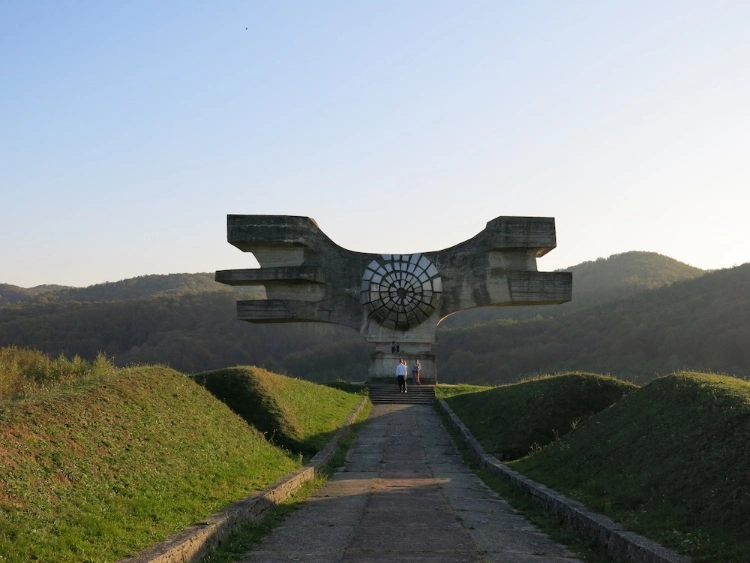
Hungarian art historian, Katalin Sinkó, who discusses the removal of the monuments undertaken by the Communist regime in her native country, stresses probably the most significant aspect of the monuments’ disfigurement: The destruction of statues as a ritual act proves significant only in an environment which understands and acknowledges the meaning of such symbolic acts.
Accordingly, in the early days of the Yugoslav Kingdom, all signs of Austro-Hungarian monarchy were removed; those monuments to the Karadjordjevic dynasty which did not fall under occupying forces in the Second World War were promptly defaced after the 1945 by the communist authorities; after the violent disintegration of Yugoslavia, the emerging nation-states started to acquire their new identity by revising (nationalist) memories, engaging thus in a ‘’ memory work’’ which is as Gills points out, like any other kind of physical labor , embedded in complex class, gender and power relations that determine what is remembered/ or forgotten , by whom, and for what end.
The main question is still here: Are there elements of reconciliation in today’s culture of monuments in the Western Balkan? Whereas it appears somehow logical to built Memorial of the Murdered Jews of Europe, 2006, in Berlin, the question is where it would be ‘’logical’’ to erect a memorial to the victims in Srebrenica.
In Belgrade, of course. But, who would (date to) built it there? Monuments, cannot offer reconciliation, but people, sometimes can.. In a public performance held in Sarajevo 1998, the Croatian artist Slaven Tolj drank for some 20 minutes Bosnian sljivovica and Croatian grappa, mixing them.
The subtitle of his performance read: ‘’Waiting for Willy Brandt’’.
We keep waiting…
SYMBOLIC SIGNIFICANCE OF MONUMENTS IN BOSNIA AND HERZEGOVINA
Following the Second World War and the victorious National Liberation War over fascism, the myth of both revolutionary justice and the true will of the Communist Party of Yugoslavia to determine the course of history have been legitimized.
The victory also underlined the prospects of small nations, such as South Slavs, to decide their own future, to create a state and to be triumphant over a much stronger enemy. The victory, thus reconciled two myths: the myth of uprising and the myth of revolution.
The National Liberation War signified a conquest over invaders, and therefore, the victory substantiated the ability of South Slavs to constitute a state rooted in principles of ‘’ brotherhood and unity ‘’. The war also signified the effort to create a new society and a new class consciousness.
For that very reason, socialist realist art in former Yugoslavia, through ‘’ sacral places’’ such as monuments, sought to create the myth that would become underline the idea of revolution, the idea of creating a new man.
The monuments were used mostly commemorated fallen soldiers. They were also used to articulate a spirit of optimism and collective will directed towards a utopian classless society. The spirit of the deceased ought to inspire both those who have survived the war and new post-war generations to further pursue revolutionary accomplishments in peace.

The common practice was to build monuments dedicated to national heroes-such as a monument to the boy –fighter Bosko Buha who was portrayed standing over an open book, holding a gun in one hand, and a bomb in the other.
Totalitarian regimes often insist on youth mobilization as it stands for a new perspective. The official ideology, thus, particularly focused on the heroic death of a minor in order to establish the myth of a new generation that through death and suffering is building a new tomorrow.
The bomb in his hand and the rifle on his shoulder embody the young fighter’s will to create a new future in which radical fighting against the enemy symbolizes the realization of an utopian truth and universal justice for all South Slavic people.
The open book over which he stands symbolizes awareness of collective solidarity and a new future built through labor, combat and knowledge. The monument was set up at the Jabuka Mountain close to Prijepolje in western Serbia, the place where he was killed.
The spirit of the place and the worship of fallen fighters represent one of the most distinct rituals among Balkan nations: the cult of the ancestor. It denotes a static timeless past for which the living must repay the dead, whereas the fallen fighter symbolizes a new future and a new utopian reality which the survivors need to build.
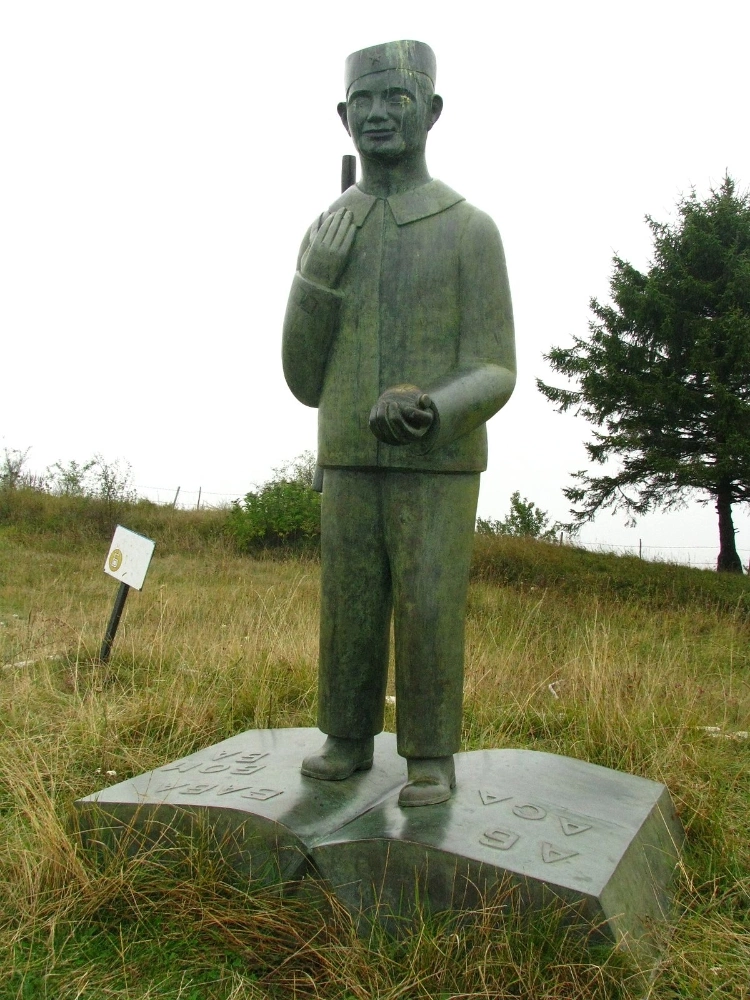
Close to the monument of Bosko Buha stands another one commemorating soldiers who fell during First World War I. in the 1900s, Serbian nationalists, with the intention of deconstructing and devaluating the communist myth of the fighter, built right next to it a monument dedicated to Serbian soldiers who were sympathetic to fascist forces and killed by Partisans.
This highlights a grotesque union of Balkan ideologies of the 20th century that aimed to attain legitimacy through blood and sacrifice. Despite seeming grossly incompatible, they held one common trait: a symbolic representation of the eternal spirit of ‘’our fallen fighters’’ through monuments which regenerate ‘’ political truth and justice’’.
Here, not only different ideologies but also borders of newly created states succeeding Yugoslavia meet: Serbia, Bosnia and Herzegovina and Montenegro. Consequently, the political body and the ‘’ brotherhood and unity’’ between the people and the South Slavic state community, all of which Bosko Buha had fought and died for, has fallen apart.
Even though his sculpture has fortunately not been torn down, it has been stripped of its symbolic meaning; a political assassination took place!
In the context of Bosnia and Herzegovina, the symbolical presentation of the National Liberation War had a great significance because its main battles and offensives were fought on the country’s territory: also, in 1943, the new Yugoslavia was established in the second session of the Anti-Fascist Council of People’s Liberation of Yugoslavia (AVNOJ) in the northern Bosnia town of Jajce.
The multiethnic life in Bosnia and Herzegovina alone seemed to reflect a ‘’miniaturized Yugoslavia’’, even the geographic centre of Yugoslavia, marked by a stone sculpture, was located near Sarajevo and Zenica cities.
In the late 1980s and 1990s, rising ethno-nationalistic fantasies have focused on ‘’under-mining communism’’. The reason why people massively adopted these ethno-nationalistic fantasies was primarily the political emptiness, a vacuum created by the fall of communism.
In this period, monuments that embodied communist tradition were often demolished. This destruction in itself had a double meaning: it sought to erase the communist past in order to make room for new identities and, at the same time, it marked the return to a pure ‘’ancient tradition’’.

However, while condemning communism as a utopian construction, nationalists turned towards an even greater illusion: a utopia that is no longer bound to the future but to the past. Thus the myth of creating a utopian future during communism has been replaced with the ethno-nationalistic myth of returning to the past.
Precisely because of the Bosnia and Herzegovina, as a representation of a ‘’miniature Yugoslavia’’, the consequences following the collapse of the social system and the Yugoslav idea of ‘’brotherhood and unity’’ were more tragic there.
One of the reasons why the war between the ‘fraternal’ nations was so blood-soaked is that the community began to fall apart internally, and the ideology which people believed in socialism with a human face-was abandoned.
This inner decay gave rise to ethno-nationalistic fantasies and identities that were based on exclusion and the denunciation of once ‘fraternal’ nations as hostile, criminal ones. Neighboring nations started to disown their own past and began finding an enemy within themselves.
Thus ‘brotherhood and unity’ between fraternal national turned into fratricide: the murder of the brother.
In this inextricable web of transition processes during 1990s, monuments and citizens in Bosnia and Herzegovina seemed to share a common fate: monuments were demolished and, at the same time, citizens were killed and imprisoned in concentration camps.
The demolition of monuments signified the collapse of the old political community while the emergence of new monuments pointed to the creation of a new political imagination and a new identity. Thus the transition from socialism to ethno-nationalism was reflected in the symbolic power of monuments and it was also reproduced in them.
In the winds of war that swept over Bosnia in the 1900s, not only were communist monuments destroyed in the name of ethno-national policies, but also any cultural heritage that now represented an enemy in ‘our nation’ was removed: the Old Bridge and Orthodox cathedral in Mostar, Ivo Andric sculpture in Visegrad, Aladza Mosque in Foca, Ferhadija in Banjaluka, John the Baptist Church near Jajce… The perpetrators of these acts were running away from themselves, from their own past, seeking refuge in a mythical past of holy kings and ancestors, who they believed would protect and renew their own national identities.
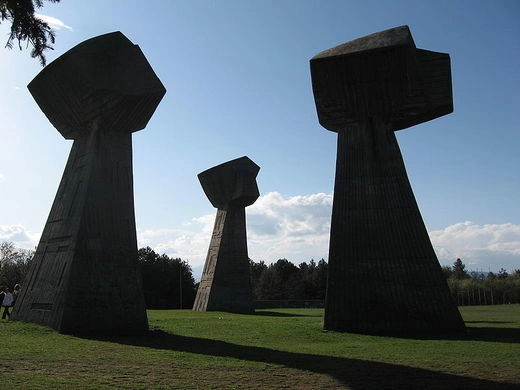
Even though the fate of Yugoslavia’s disintegration with all its tragic consequences, became fully visible during the war in Bosnia and was perhaps most notably woven into monuments in the country, not all of the monuments were expressions to constitute political authority in times of war.
On the contrary, they also symbolize a manifold tradition of diverse cultures that did not form in opposition to each other, but through subtle intertwining and constant interaction which had characterized the way of life in Bosnia for centuries.
The famous Old Bridge in Mostar, which was destroyed during fighting in 1993, did not simply represent the identity of the nation, but it rather opened a place for everyday encounters of manifold, intertwining identities from diverse nations.
Ultimately, the question arises as to how trauma experienced by the victims during the war in Bosnia and Herzegovina can be expressed through monuments? In which way can a sculpture commemorate the innocents that perished in the past without fostering the impression that crimes ate the only paradigms to be embedded within the collective memory?
Nowadays, no great ideology exists that could give meaning to the victims as part of a vision of future progress and improvement. Hence monuments that could form a new political consciousness are not built anymore.
However, a need of the people- of those who survived and feel remorse- still exists to express closeness to those who have perished. A rare example is the memorial cemetery in Potocari, close to Srebrenica.
Through the simplicity of its smooth stone and the names of the deceased written onto it, reflects some sort of relation of the living towards the dead. It does not emphasize the lament over the Srebrenica genocide but rather expresses an overwhelming pain that in its ineffability exceeds rational imagination and understanding.
In this way, the monument eludes any narcissistic awareness of collective victimization, the kind of which, unfortunately, is all too often part of the ritualized and populist discourse of the political and religious elite in Bosnia and Herzegovina.
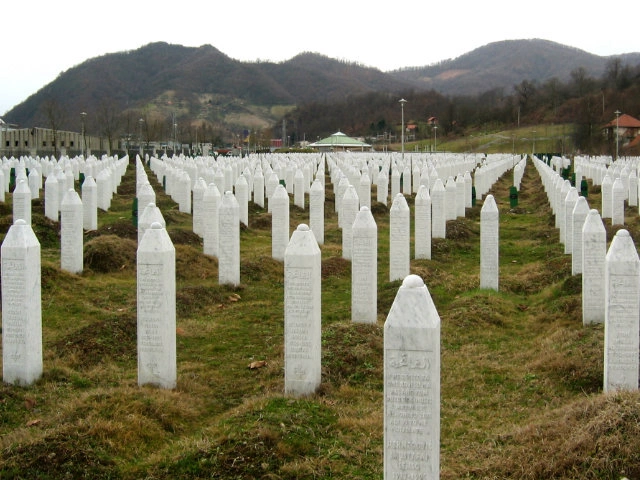
The current socio-political climate is marked by the Dayton Peace Agreement of 1995 that ended, or better froze, the war and represents an intersection of contradictory processes that are reflected by newly built monuments.
On the one hand, national aspirations exist regarding the separation of territories and their annexation to neighbouring countries, namely Serbia and Croatia. Thus, in the south-western Bosnian town of Tomislavgrad, stands a monument showing the medieval Croatian King Tomislav.
The monument embodies a mythical past aimed at legitimizing national sovereignty over a certain territory as well as state autonomy. Therefore, the medieval king represents neither elitism that rises above the working class, nor does he embody any aristocratic or divine nobility.
Instead he illuminates the origin of exclusive national will, the power of national unity and harmony. On the other hand, the general commercialization of society stultifies the meaning of public good, leading to the arbitrary placement of cheap symbols and superficial memorial inscriptions.
An example is the sculpture Multi-Ethnic Man, a donation from Italy that was placed in the Svjetlost Park in central Sarajevo. In its banality and impersonality, the sculpture seems to deny the very idea of multi-ethnicity.

In order to create a new political community, or a new unity in Bosnia and Herzegovina, it is necessary to consider all lines of separation and the symbolical power that has divided people and which is expressed by monuments and sculptures.
Then, finally, it may be able to let out the cathartic cry of liberation from the bloody past and thereby at the same time embody the sense for new multi-ethnic unity.

About David Fox
David Fox is an artist who created davidcharlesfox.com to talk about art and creativity. He loves to write, paint, and take pictures. David is also a big fan of spending time with his family and friends.
Leave a Reply
 |
 |
 |
 |
Just Art and Fun
Now get FREE Gifts. Or latest Free phones here.
Disable Ad block to reveal all the secrets. Once done, hit a button below
 |
 |
 |
 |